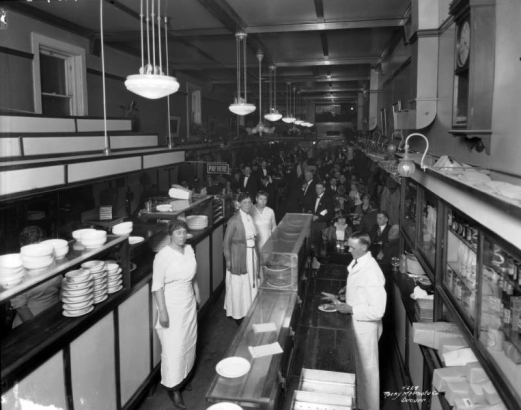Hardly a day passes at Denver Public Library's Western History/Genealogy Department that someone doesn't mention massive changes that have swept the Mile-High City over the past few years.
Nowhere is the pace of change more visible than in the constant churn of restaurants and bars that keep the Mile-High City fed and watered. Plenty of beloved Denver eateries have been sacrificed at the altar of growth, seemingly leaving nothing more than memories of hot meals and good times with friends and family.
The graveyard of Denver eateries is the subject of a wonderful new book by Colorado authors Robert and Kristen Autobee titled, Lost Restaurants of Denver. This meticulously-researched gem recalls dozens of shuttered restaurants going all the way back to Denver's earliest days. Of course the sections most of us will head to immediately are those that cover restaurants from the 20th Century including The Flying Dutchman, Valente's, The Yum Yum Tree, Round the Corner, and many more forgotten favorites.
Besides detailing a bit of each restaurant's histories, the Autobees unearthed plenty of historical gems including photos of table settings from some of the restaurants and plenty of recipes. One recipe that stands out both for its simplicity and its unassailable Denver pedigree is the North Denver Canoli.
The North Denver Canoli is nothing like the creamy dessert most of us are familiar with and is more like its mainstream cousin, the calzone. This dough-wrapped sausage with a slice of pepper was the brainchild of Denver sausage impresario Richard Carbone. Carbone, legend has it, was reluctant to toss out leftover pizza dough from his North Denver kitchen and used those scraps to create the canoli.
While no one is quite certain how the name canoli got attached to this tasty treat, the name stuck and is still used by those whose time in Denver pre-dates any neighborhood with a marketing slogan for a name. (LoDo and RiNo, we're looking at you.)
Though most of the restaurants the Autobees recall will leave readers longing for the good old days, some of them will leave readers with a bad taste in their mouths that wasn't caused by a poorly prepared meal. In the early years of the 20th Century, Denver was home to a particularly racist chili restaurant called, The White Peoples Chile Parlor.
This not-so-charming eatery stands as a stark reminder that the good old days weren't that good for everyone.
The Autobees drew on a number of sources while researching their book, including WHG's Digital Collections and Menu Collection. In doing so, they've created a wonderful document that's useful for researchers and foodies alike.
Whether you grew up in the shadow of The Yum Yum Tree, or just moved here last year, Lost Restaurants of Denver can provide you with a crash course in Colorado's culinary history that will leave you longing for meals you'll never be able to enjoy, like a bowl of Pagliacci's unforgettable minestrone.


Comments
Hi, am trying to find the
Hi, am trying to find the address and any photos of a small, long closed eatery called The Sandwich Tree. I met my wife to be there in 1968.
The Sandwich Tree was located
The Sandwich Tree was located at 7315 E. Colfax.
and of course all you could
and of course all you could eat Wednesday-spaghetti @ the Denver Drumstick.
What was the name of the
What was the name of the restaurant on th SE corner if Colo. Blvd. and yale in the 70s
Chicago Speakeasy
Chicago Speakeasy
early 70s was Ground Round
early 70s was Ground Round
Apple Tree Shanty and Baby
Apple Tree Shanty and Baby Does
Where was the White Peoples
Where was the White Peoples Chile Parlor? Reprehensible.
55 yrs ago I was 5, we would
55 yrs ago I was 5, we would go to a home that was converted into a Mexican restaurant, somewhere around Broadway or Acoma, around 3rd or 4th in Denver, I vividly remember it..but not the name!
Can someone remember the
Can someone remember the restaurant that was on east Hampden Ave, about a mile east of I-25 on the north side of the street? It had all kinds of crazy decor hanging from the ceiling and hung on the walls. Great burgers!
Add new comment